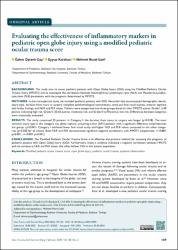Evaluating the effectiveness of inflammatory markers in pediatric open globe injury using a modified pediatric ocular trauma score

Göster/
Erişim
info:eu-repo/semantics/openAccesshttp://creativecommons.org/licenses/by-nc/3.0/us/Tarih
2024Üst veri
Tüm öğe kaydını gösterÖzet
BACKGROUND: This study aims to assess pediatric patients with Open Globe Injury (OGI) using the Modified Pediatric Ocular
Trauma Score (MPOTS) and to investigate the correlation between Neutrophil-to-Lymphocyte ratio (NLR) and Platelet-to-Lymphocyte ratio (PLR) parameters with the prognosis determined by MPOTS.
METHODS: In this retrospective study, we included pediatric patients with OGI. Recorded data encompassed demographic details,
injury type, duration from injury to surgery, complete ophthalmological examinations, initial and final visual acuities, anterior segment
and fundus findings, and NLR and PLR values. Patients were categorized into three groups based on their MPOTS scores: Grade I (≤30
points), indicating high risk; Grade II (35-65 points), moderate risk; and Grade III (≥70 points), low risk. Differences between categories
were statistically evaluated.
RESULTS: The study comprised 22 patients. In Category I, the duration from injury to surgery was longer (p=0.018). The most
common injury type in this category was globe rupture, occurring in four (50%) patients, with a significant difference noted between
the groups (p=0.041). Category I exhibited lower final visual acuity and higher NLR and PLR values compared to the other categories (p<0.050 for all values). Both NLR and PLR demonstrated significant negative correlations with MPOTS (respectively, r=-0.869,
p<0.001; r=-0.809, p<0.001).
CONCLUSION: The Modified Pediatric Ocular Trauma Score is an effective and practical method for assessing the prognosis of
pediatric patients with Open Globe Injury (OGI). Furthermore, there is evidence indicating a negative correlation between MPOTS
and the increase in NLR and PLR values that often follows OGI in this patient population. AMAÇ: Bu çalışma, açık glob yaralanmalı (AGY) pediatrik hastaları modifiye pediatrik oküler travma skoru (MPOTS) ile değerlendirmeyi ve nötro- fil/lenfosit oranı (NLO), trombosit/lenfosit oranı (TLO) parametrelerinin prognoz ve MPOTS ile ilişkisini incelemeyi amaçlamaktadır. GEREÇ VE YÖNTEM: Bu retrospektif çalışma, AGY'li pediatrik hastalar üzerinde yapılmıştır. Hastaların demografik verileri, yaralanma tipi, yara- lanma-ameliyat süresi, tam oftalmolojik muayeneleri, başlangıç ve son görme keskinlikleri, ön segment ve fundus bulguları, NLO ve TLO kaydedildi. Hastalar MPOTS skorlarına göre üç kategoriye ayrıldı: kategori 1 (≤30 puan), yüksek risk; kategori II (35–65 puan), orta risk; ve kategori III (≥70), düşük risk.Kategoriler arasındaki farklılıklar istatistiksel olarak değerlendirildi. BULGULAR: Çalışmaya 22 hasta alındı. Kategori 1'de yaralanma-ameliyat süresi daha uzundu (p=0.018). Kategori 1'de en sık görülen yaralanma tipi 4 (%50) hastada glob rüptürü idi ve gruplar arasındaki fark anlamlıydı (p=0.041). Kategori 1 diğer kategorilere göre daha düşük son görme kes- kinliğine ve daha yüksek NLO ve TLO değerlerine sahipti (tüm değerler için p<0.050). NLO ve TLO, MPOTS ile anlamlı negatif korelasyona sahipti (sırasıyla, r= -0.869, p<0.001; r= -0.809, p<0.001). SONUÇ: MPOTS, pediatrik AGY hastalarının prognozunu değerlendirmek için etkili ve pratik bir yöntemdir. Pediatrik hastalarda AGY sonrası NLO ve TLO'nun MPOTS ile negatif korele olduğu gösterilmiştir.
Kaynak
Ulusal Travma ve Acil Cerrahi DergisiCilt
30Sayı
2Koleksiyonlar
Aşağıdaki lisans dosyası bu öğe ile ilişkilidir:


















